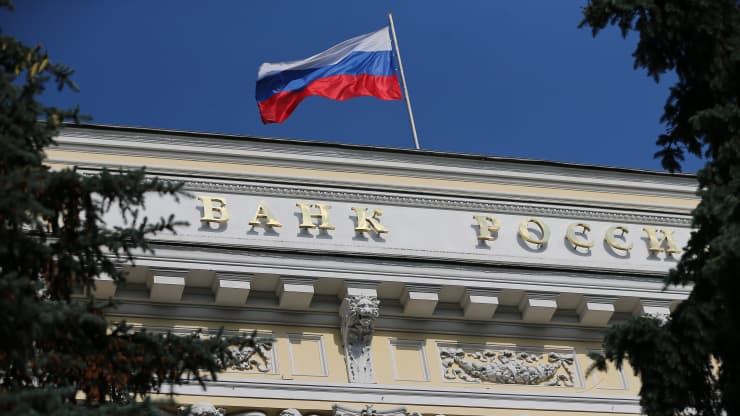
Gavriil Grigorov | TASS | Getty Images
Russia’s central bank on Monday more than doubled the country’s key interest rate from 9.5% to 20% as its currency, the ruble, hit a record low against the dollar on the back of a slew of new sanctions and penalties imposed on Russia by Europe and the U.S. for its invasion of Ukraine.
The rate hike, the central bank said, “is designed to offset increased risk of ruble depreciation and inflation.”
This follows the central bank’s order to halt foreigners’ bids to sell Russian securities in an effort to contain the market fallout. The ruble fell as far as 119.50 per dollar, down a whopping 30% from Friday’s close.
The bank also said it would be freeing 733 billion rubles ($8.78 billion) in local bank reserves to boost liquidity. Russian Central Bank Governor Elvira Nabiullina will hold a briefing at 1 p.m. London time Monday.
The dramatic developments underline fears of a run on Russia’s banks. Already, long lines to withdraw cash have been seen at ATMs in Russian cities. Sberbank Europe, which is owned by Russia’s state-run Sberbank, says it has experienced “significant outflows of deposits in a very short time.”
In a statement Monday, the Russian finance ministry and the central bank announced plans to order domestic exporters to sell their foreign exchange revenues starting on Feb. 28. The move will order exporters to sell 80% of all their forex revenues received under export contracts.
Over the weekend, the U.S., European allies and Canada agreed to cut off key Russian banks from the interbank messaging system, SWIFT, which connects more than 11,000 banks and financial institutions in over 200 countries and territories. The EU also announced Sunday it was shutting its airspace to Russian aircraft.
Read more: Biden says U.S. will sanction Russian banks, sovereign debt and individuals after Ukraine ‘invasion’
The volatility in Russian markets “does show that the freezing of the Russian central banks assets, which was decided over the weekend by the EU as well as the other western countries led by the U.S. — it shows what a significant move that is,” David Marsh, chairman of economic policy think tank OMFIF, told CNBC’s “Squawk Box Europe” on Monday.
“That is actually much more significant than the SWIFT action, which was breaking a taboo by Germany when it joined in on that over the weekend,” he said, referring to sanctions that cut several Russian banks out of the global SWIFT payments system.
“It does mean that there is going to be this enormous scramble for dollars in Russia — we’ve seen the queues outside the banks and so on.”
Russia over the past several years has amassed a war chest of some $630 billion in foreign reserves, its highest level ever, which analysts say will help it withstand sanctions and losses in export revenue. But if some of those assets are frozen, that changes the calculus for Russia.
“We will paralyze the assets of Russia’s central bank,” EU Commission President Ursula von der Leyen said in a statement Sunday. “This will freeze its transactions. And it will make it impossible for the Central Bank to liquidate its assets.”
“The fact that the Russians cannot deploy a good part of this $600 billion worth of foreign currency reserves that the Russian central bank has been carefully building up does mean that we are onto an emergency war economy,” Marsh said. “And the idea of isolating Russia, which just a few days ago would have been thought of as unthinkable, it now is a reality.”
The ramp-up in punitive measures against Russia — the strongest that the EU has ever deployed against it — come as Russian forces deployed by President Vladimir Putin carry out offensives all over Ukraine. It follows several days of heavy shelling and missile strikes in major urban centers including Ukraine’s two largest cities, its capital Kyiv and Kharkiv, which together have a population of nearly 5 million people.
Ukrainian forces have so far managed to hold back the Russian advances and remain in control of the two cities, Ukraine’s defense ministry said on Sunday.

